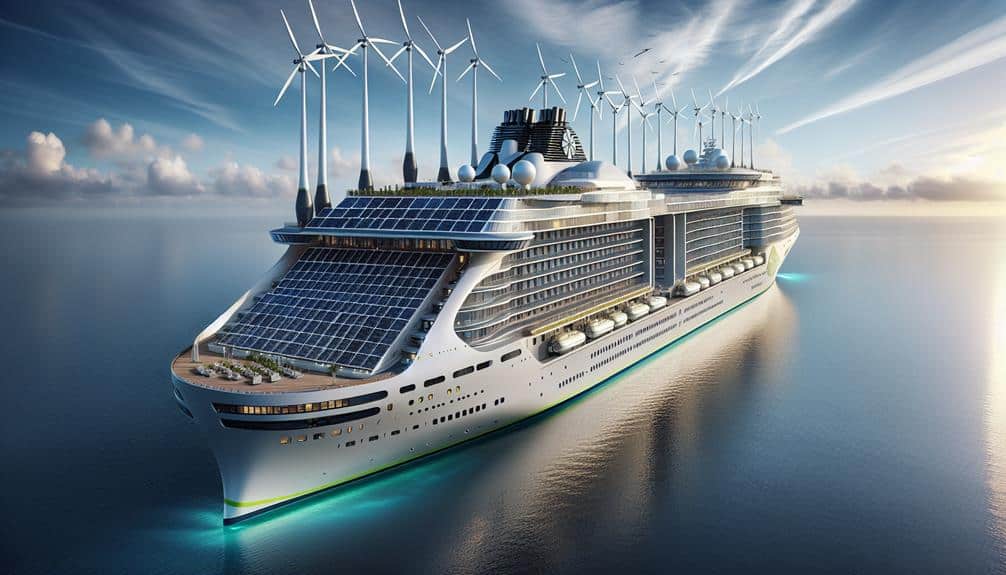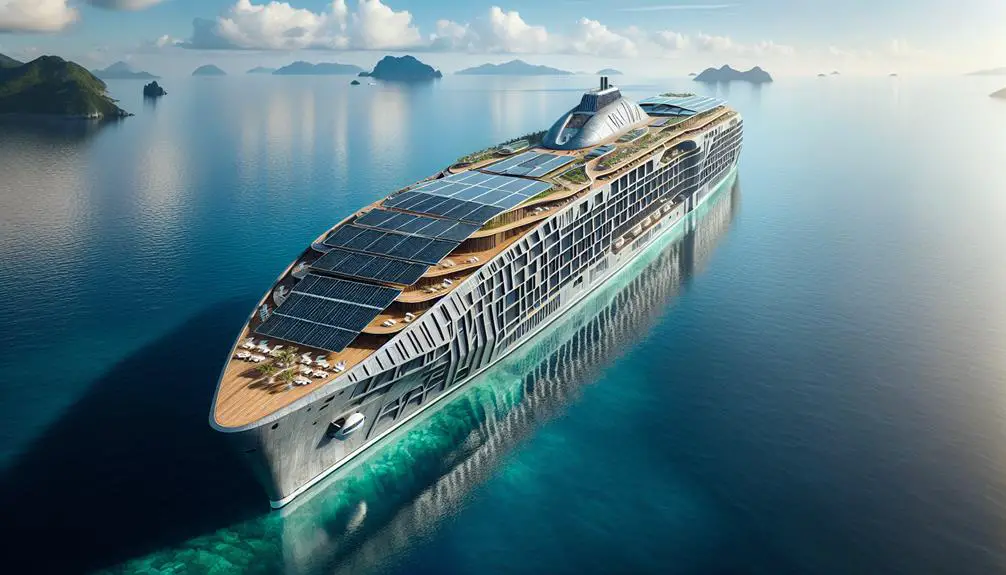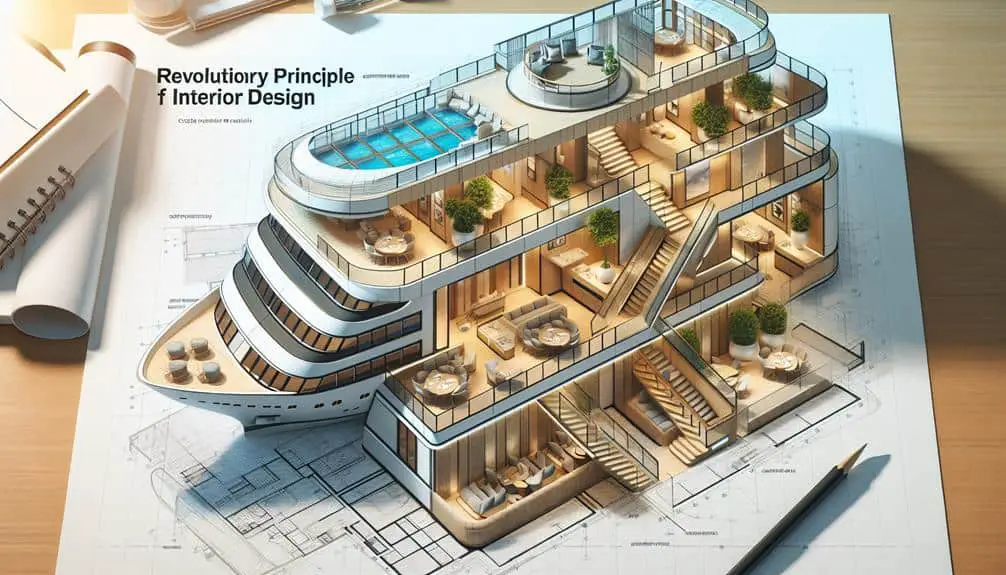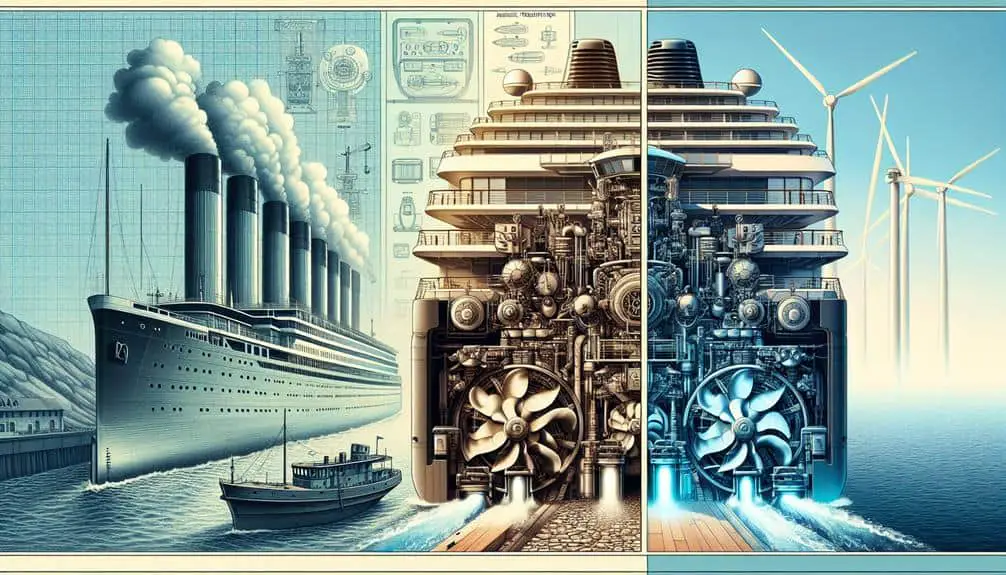Incorporating energy-saving initiatives into cruise ship architecture is essential. By using energy-efficient lighting systems, natural light optimization, and smart sensors, artificial lighting reliance decreases. Sustainable materials like recycled steel and eco-friendly paints reduce the ship's carbon footprint. Efficient HVAC systems, advanced power management, and renewable energy integration further enhance efficiency. These initiatives impact design, construction, and operation, promoting sustainability. Additional details on each aspect can provide a deeper understanding of their significance.
Key Points
- Energy-efficient lighting reduces reliance on artificial lighting, enhancing sustainability.
- Sustainable materials and construction techniques minimize the carbon footprint.
- Optimal HVAC systems and insulation promote energy efficiency and comfort.
- Advanced power management solutions optimize energy use and distribution.
- Integration of renewable energy reduces environmental impact and enhances resilience.
Energy-Efficient Lighting Systems
When designing cruise ship architecture, incorporating energy-efficient lighting systems is essential to reduce power consumption and environmental impact. Utilizing daylight harvesting strategies and energy-efficient window design can significantly decrease the reliance on artificial lighting during daylight hours. By strategically placing windows and utilizing glazing technologies that maximize natural light penetration while minimizing heat gain, cruise ships can lower their overall energy usage.
In addition to passive design strategies, implementing smart sensors and automated lighting controls further enhance energy efficiency. Smart sensors can detect occupancy levels and adjust lighting accordingly, ensuring that lights are only on when needed. Automated lighting controls allow for precise management of lighting levels, dimming or turning off lights in unoccupied areas automatically.
Sustainable Materials and Construction
Utilizing sustainable materials and innovative construction techniques is paramount in optimizing the environmental performance of cruise ship architecture. When selecting eco-friendly materials, cruise ship designers prioritize options like recycled steel, reclaimed wood, and low-VOC paints to minimize environmental impact. These materials not only reduce the carbon footprint of the construction process but also contribute to the overall sustainability of the vessel.
Incorporating green construction techniques such as modular construction and prefabrication can further enhance the eco-friendliness of cruise ship architecture. By assembling components off-site and reducing construction waste, these methods promote efficiency and sustainability throughout the building process. Additionally, the use of advanced insulation materials and energy-efficient windows helps regulate indoor temperatures and reduce the ship's overall energy consumption.
Optimal HVAC Systems for Efficiency
To optimize energy efficiency in cruise ship architecture, selecting and implementing ideal HVAC systems is essential. When designing HVAC systems for cruise ships, incorporating smart controls is important. Smart controls allow for precise regulation of temperature and airflow, ensuring energy isn't wasted on unnecessary cooling or heating. Additionally, these systems can be integrated with the ship's overall automation for seamless operation.
Insulation techniques play a crucial role in the efficiency of HVAC systems. Proper insulation reduces heat transfer, helping to maintain desired temperatures with less energy consumption. Insulating air ducts, walls, and windows can prevent thermal losses and gains, creating a more stable indoor environment. By investing in high-quality insulation materials, cruise ships can improve the overall performance of their HVAC systems to a great extent.
Advanced Power Management Solutions
In optimizing cruise ship architecture for energy efficiency, a critical aspect to ponder is the implementation of advanced power management solutions. These solutions involve the integration of smart grid technologies and advanced energy monitoring systems to regulate power distribution and consumption effectively. Smart grids enable the ship to balance energy supply and demand dynamically, optimizing the operation of onboard systems. Energy monitoring systems provide real-time data on energy usage, allowing for precise adjustments to be made to enhance efficiency further.
Implementing advanced power management solutions on cruise ships involves sophisticated control systems that can intelligently allocate power based on demand. These systems guarantee that energy is distributed efficiently to different areas of the ship, minimizing wastage and reducing overall energy consumption. By incorporating smart grid technology and energy monitoring capabilities, cruise ships can achieve significant energy savings while maintaining operational excellence.
Integration of Renewable Energy Sources
Integrating renewable energy sources into cruise ship architecture greatly enhances energy efficiency and sustainability. Renewable energy integration involves incorporating technologies like solar panels, wind turbines, and even wave energy converters into the ship's design. These systems harness natural resources to generate electricity, reducing the reliance on essential fuel sources and lowering operational costs.
Energy saving design innovation plays an important role in maximizing the benefits of renewable energy integration. Cruise ships are incorporating smart energy management systems that optimize the use of renewable power sources based on real-time energy demand. For example, excess energy generated by solar panels during the day can be stored in batteries and used during peak hours or when the ship is at port.
Furthermore, the integration of renewable energy sources not only reduces the environmental impact of cruise ships but also enhances their resilience to external factors such as fuel price volatility and regulatory changes. By embracing renewable energy technologies, cruise ship architects pave the way for a more sustainable and efficient future in maritime transportation.
Frequently Asked Questions
How Do Energy-Saving Initiatives on Cruise Ships Impact the Overall Guest Experience?
Energy-saving initiatives on cruise ships greatly enhance the overall guest experience by boosting guest satisfaction through a cleaner environment and demonstrating a commitment to reduce the vessel's environmental impact. This improves the onboard experience.
Are There Any Potential Drawbacks or Limitations to Implementing Energy-Efficient Technologies on Cruise Ships?
When implementing energy-efficient technologies on cruise ships, you may encounter cost implications and design challenges. However, the benefits far outweigh these concerns. Efficiency improvements can markedly reduce operational costs and enhance environmental sustainability.
How Do Energy-Saving Initiatives on Cruise Ships Affect the Overall Maintenance and Operational Costs?
When you integrate energy-saving initiatives on cruise ships, operational efficiency improves, leading to significant cost savings. By optimizing systems and utilizing sustainable solutions, maintenance becomes streamlined, reducing overall operational costs and enhancing the ship's performance.
What Are Some of the Challenges Faced When Integrating Energy-Saving Technologies Into Existing Cruise Ship Architecture?
When retrofitting technology for energy efficiency on cruise ships, challenges arise in integrating new systems into existing architecture. Balancing space limitations, structural modifications, and system compatibility demands careful planning and implementation to guarantee success.
How Do Energy-Saving Initiatives on Cruise Ships Contribute to Reducing the Environmental Footprint of the Cruise Industry as a Whole?
To reduce emissions and enhance sustainability, energy-saving initiatives on cruise ships play an important role. Sustainable design practices such as optimized propulsion systems and advanced lighting solutions greatly contribute to lessening the environmental footprint of the cruise industry.




